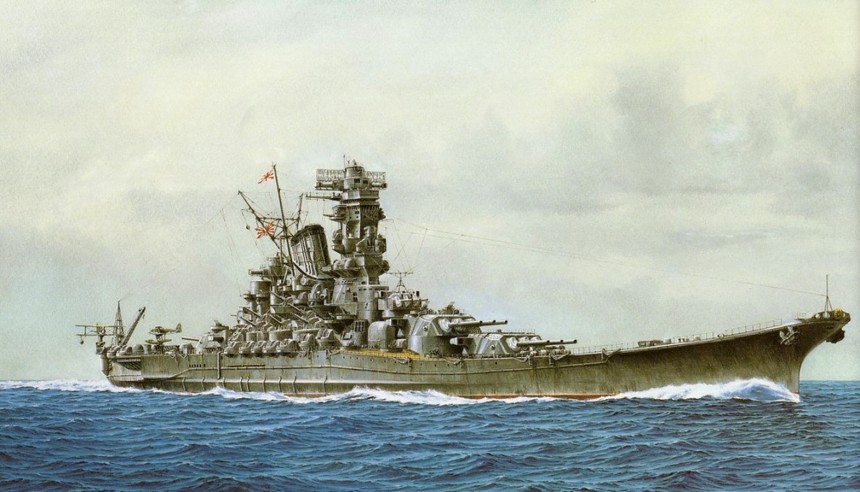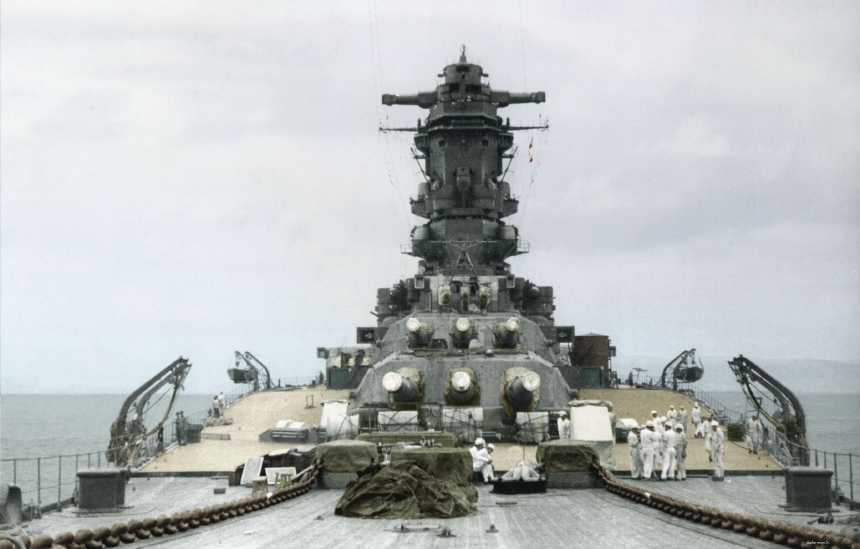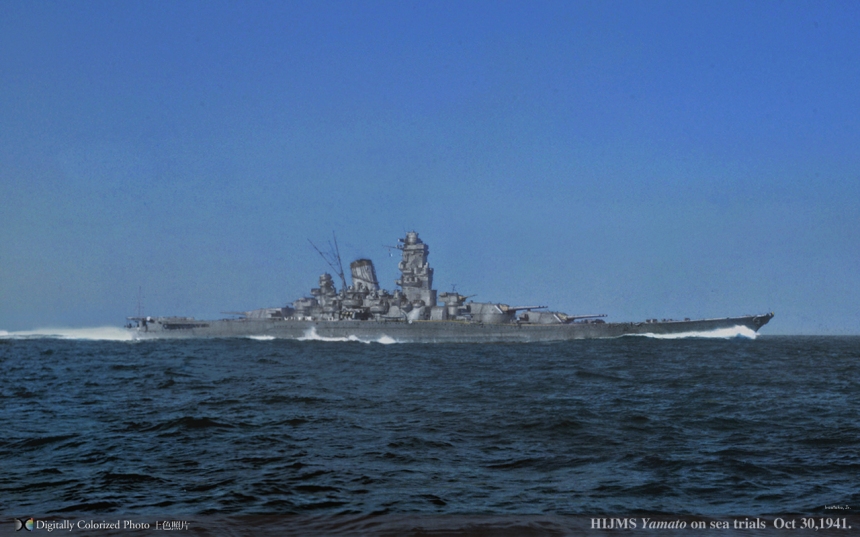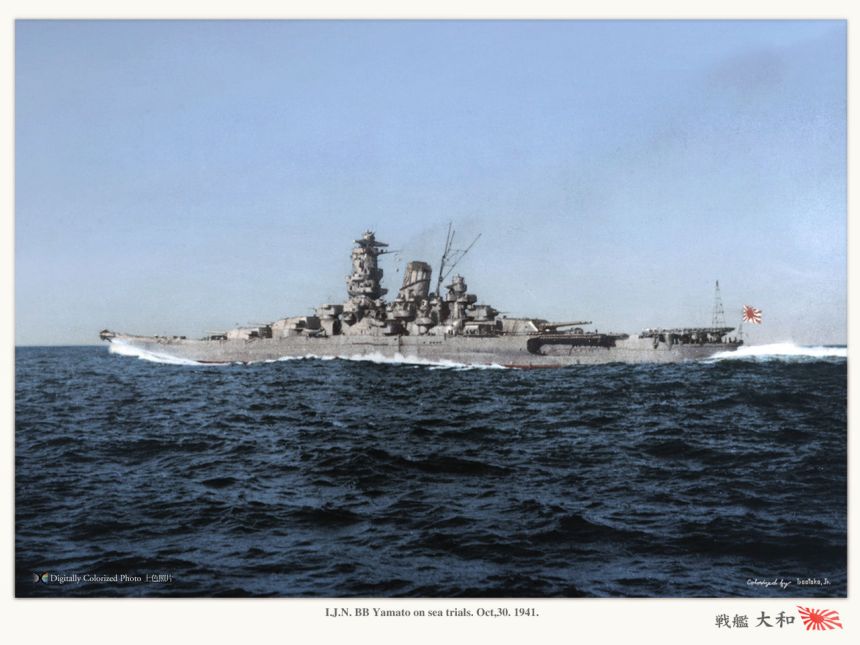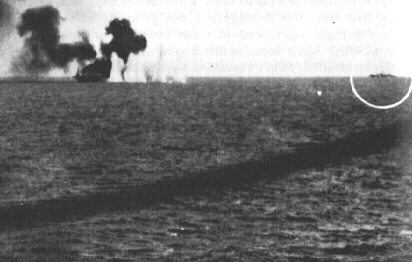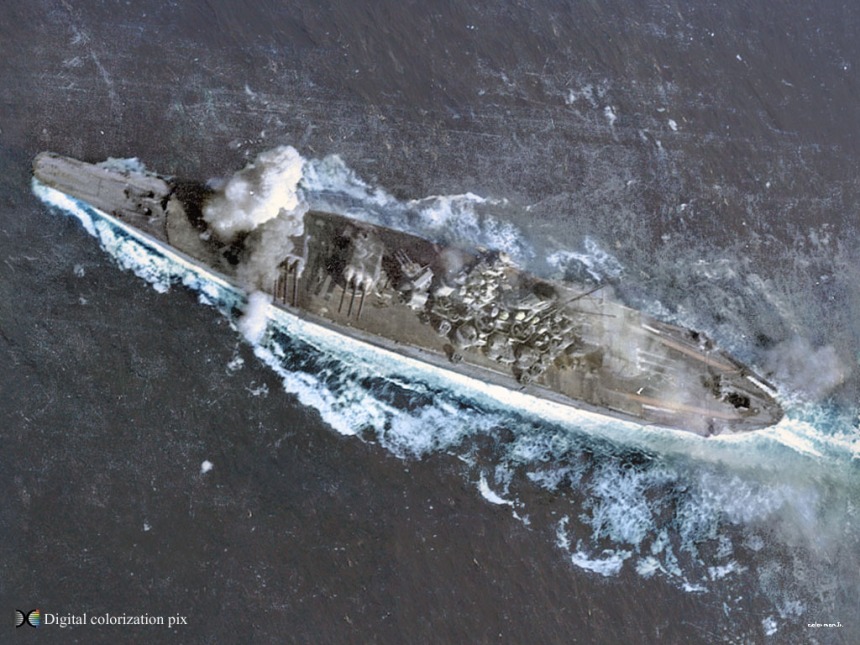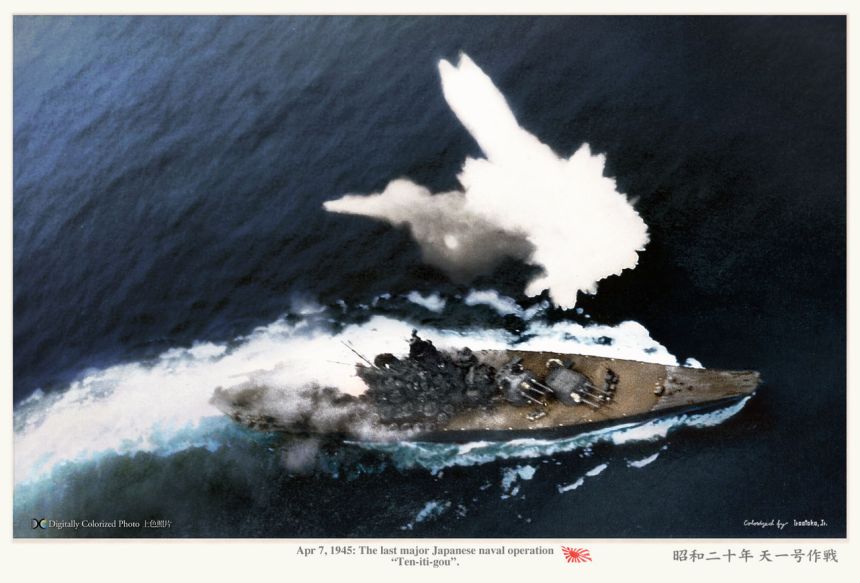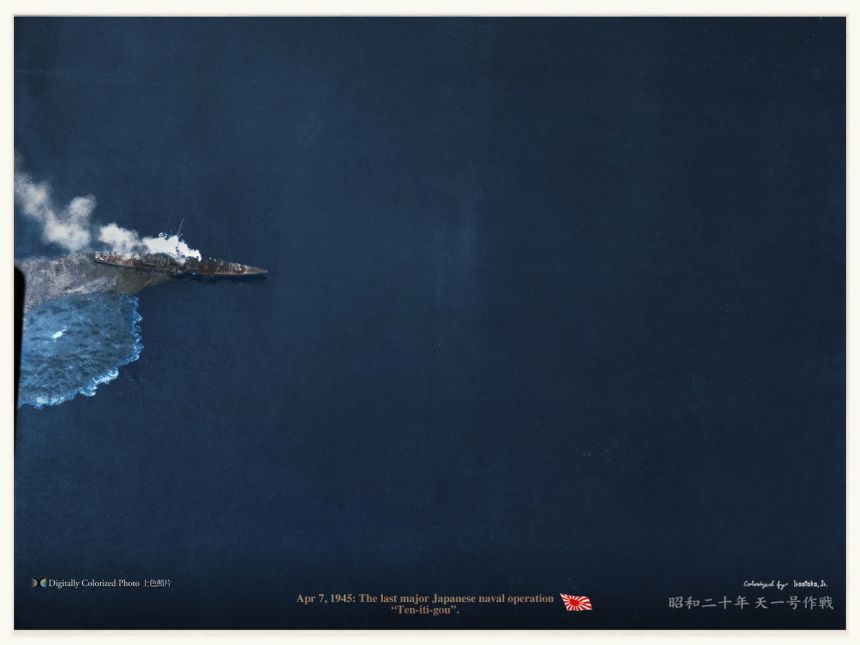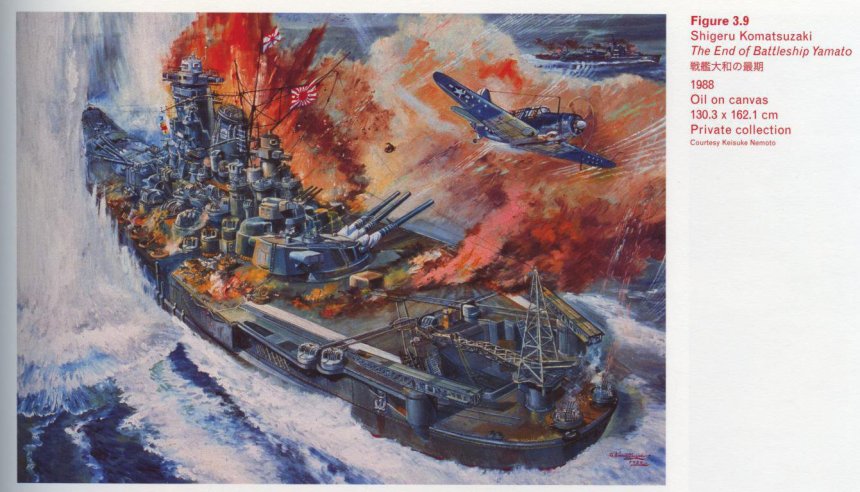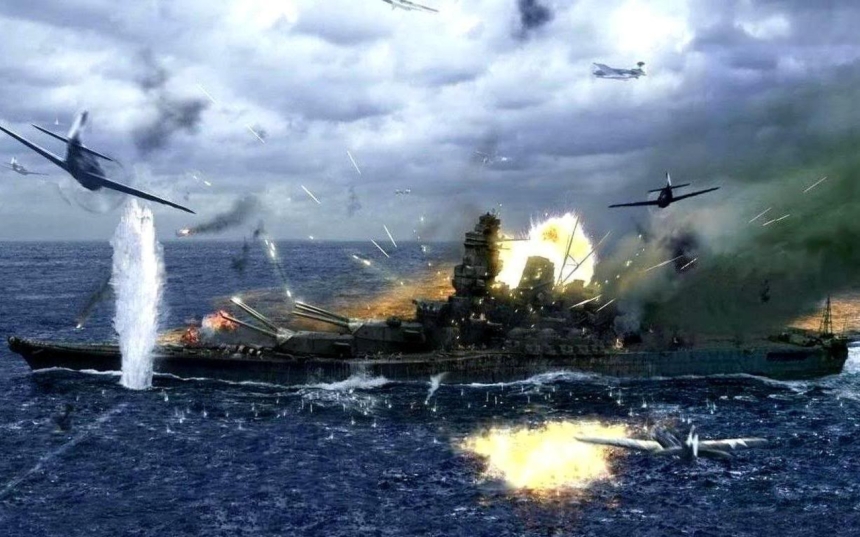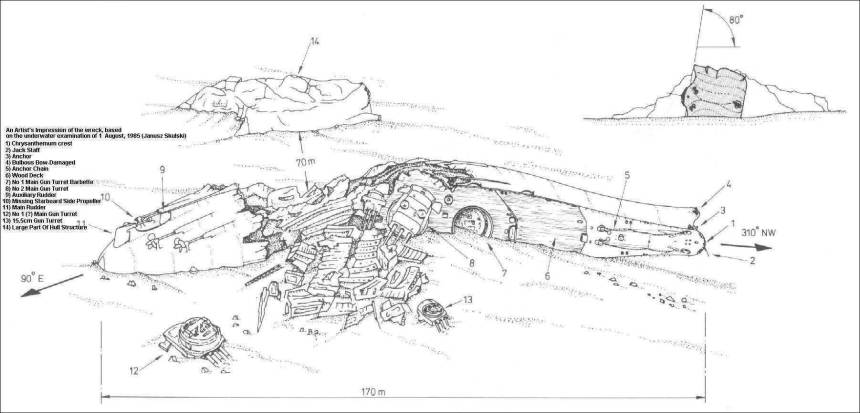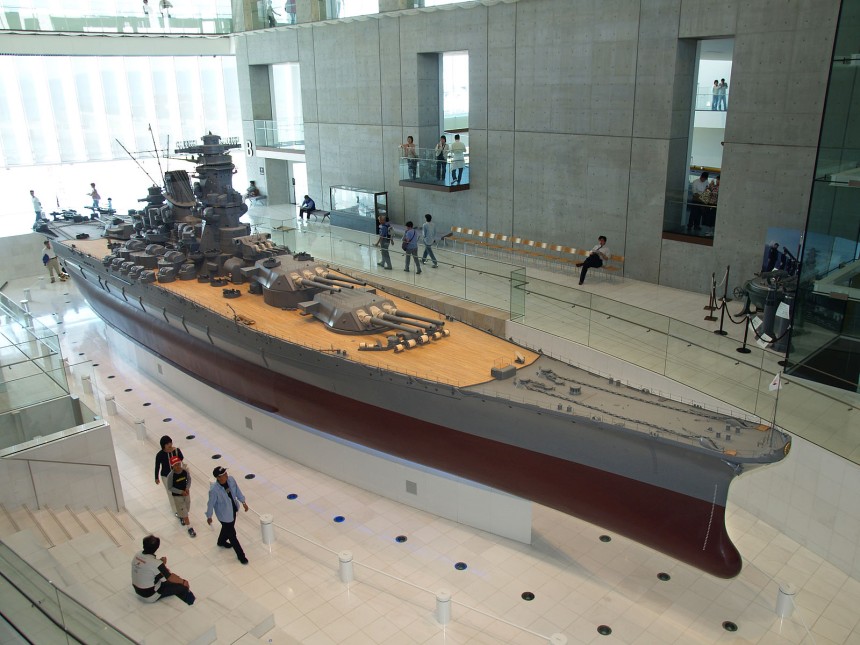Warship Wednesday April 9, The Last Ride of the Yamato
Here at LSOZI, we are going to take out every Wednesday for a look at the old steam/diesel navies of the 1859-1946 time period and will profile a different ship each week.
– Christopher Eger
Warship Wednesday April 9, The Last Ride of the Yamato
Here we see the massive mega battleship Yamato of the Imperial Japanese Navy fitting out at Kure DY in 1941. Up until 1934 the Japanese paid lip service to the various Naval Treaties that limited the size and number of warships in the world’s navies. For instance, the huge cruisers designed in this period were ‘officially’ under 10,000-tons (although they rose to almost twice this amount when fully armed, loaded, and armored in WWII). The official limit on battleship size was 35,000-tons and Western ships, such as the new USS Washington class in the US and the HMS King George V-class battleships in the UK.
Well in 1934 Japan dropped out of the agreement and the gloves came off. They soon designed the largest battle-wagon in the world.
Ever.
At full load these ships would top out at 72,000-tons. The next closest rival in size was the US Iowa class, which at their heaviest displacement pushed some 50,000-tons on a hull that was about twenty feet shorter. However the Yamato was twenty feet *wider* and as such was a very beamy girl. She also drew more than 35-feet of seawater under her hull, which limited her moorings considerably.
These ships were amazingly armored, more so than any ship before or since. This included :
650 mm (26 in) on face of main turrets (YES, 26-inches!)
410 mm (16 in) side armor belt
200 mm (7.9 in) central(75%) armored deck
226.5 mm (8.92 in) outer(25%) armored deck
As point of reference the second place winner for the most armor carried was on the USS Iowa class battlewagons, which had some 19.7-inches on turret faces and a 12-inch belt.
These ships could put up some lead, carrying an amazing 205 pieces of artillery from the giant 18.1-inch main guns (the largest in the world)
to a huge array of AAA weapons. This included (in 1945):
9 × 46 cm (18.1 in) (3×3) (firing 3,000-lb shells)
6 × 155 mm (6.1 in) (2×3)
24 × 127 mm (5.0 in)
162 × 25 mm (0.98 in) Anti-Aircraft (52×3, 6×1)
4 × 13.2 mm (0.52 in) AA (2×2)
In short, these ships were massive war-engines and are seen by many as the pinnacle of battleship design (no offense to the Iowas). I mean 18-inch guns, 26-inches of armor, come on. As further protection against aircraft, her 18-inch guns could fire special “Common Type 3” anti-aircraft shells, known to the Japanese as “Sanshiki“. These shells contained over 900 incendiary tubes each capable of shooting 16-foot flames in all directions once the shell exploded. Not something you would want to fly into.
Five of the class, Yamato, Musahsi, and Shinano (along with two hulls, “Warships No 111″, and “797“) were envisioned for the Combined Fleet, with Yamato being laid down in 1937. The last two never were never finished while Shinano was converted to an aircraft carrier.
Commissioned 16 December 1941, Yamato came out of the yard a week too late for Pearl Harbor. As flagship of the fleet until 1943 when her sister ship Musashi was completed, she spent the first part of the war in such duty appropriate for such a large ship– being the primary ride of Adm. Yamamoto, from which he lost the Battle of Midway from her decks.
After 1943 she was relegated to a high-speed, heavily armored transport, running troops and valuables from island to island just ahead of Adm Nimitz’s oncoming horde that was the US Navy. Ironically her giant guns were useless to the Japanese at Guadalcanal as only armored piercing shells, made for sinking ships, and not HE shells for shore bombardment were in use at the time. If there had been, the Marines on Henderson Field may have had a very different outcome.
She dodged several torpedoes from US submarines until the end of 1943 when USS Skate (SS-305) pumped a fish into her. Damaged but not sunk (I mean come on she was 72,000-tons!), she next appeared in the pivotal battles in the Philippines in 1944. There she helped escort Ozawa’s Mobile Fleet during the Battle of the Philippine Sea, then caught up with the half-dozen small US Jeep carriers of Taffy 3, firing at the 7800-ton Casablanca-class escort carrier USS Gambier Bay on 25 October 1944.
It was during that engagement that, while firing shells marked with dye to better call shot from individual guns, an American sailor called out “They are shooting at us in Technicolor!”
The Yamato closed to within point-blank distance of Gambier Bay, now dead in the water, and shelled the tiny flat top until she sank with great loss of life. It was one of the few recorded instances of a battleship sinking a carrier in warfare. Carriers, however had already had their way with the class, sinking Yamato‘s sister ship Musashi the previous day during the Battle of the Sibuyan Sea, taking 17 bomb and 19 torpedo hits, with the loss of 1,023 of her 2,399-man crew. This left Yamato an orphan of her class, as Shinano, converted to an aircraft carrier, had been sunk earlier that month, the largest naval vessel to have been sunk by a submarine.
Retiring from the Philippines, Yamato was almost all that was left of the Japanese fleet that was still battle worthy, forming a reserve with the old WWI-era battleship Nagato and the fast battleship Kongo. Well, Kongo was sunk by USS Sealion (SS-315) on 21 November, leaving just Nagoto who was soon to be relegated to coast defense only, and Yamato as the IJN’s last capital ships.
In April 1945, with the US invasion of Okinawa, the Emperor demanded action from what was left of the Navy. This led Vice Chief of the Imperial Japanese Navy General Staff, and Chief of Staff of the Combined Fleet, Vice Admiral Seiichi Ito to scrape together all he could to sail against the Americans.
This meant the Yamato.
Her battle fleet was simply the 6000-ton Agano-class light cruiser Yahagi and 8 destroyers. Since it was to be a one-way mission, the naval kamikaze strike against a fleet that outnumbered it by a factor of at least 6:1, Ito would personally command it.
Dubbed “Operation Ten-Go” (Heaven One), the fleet sortied on 7 April directly towards Okinawa. There it was soon confronted by over 400 carrier based strike planes of Adm. Marc Mitscher’s fleet of 11 flattops, more than the Japanese had at Pearl Harbor against eight battleships.
It was not a long engagement.
By 1200 the first aircraft appeared over Yamato. By 1400 the cruiser Yahagi, riddled with bombs and torpedoes, sank along with half of the destroyer screen. By 1420, Yamato was dead in the water, her rudder shot away, her superstructure ablaze.
She has suffered more than 11 torpedo hits and six bomb hits. At 1423, one of the two bow magazines detonated in a tremendous explosion. The resulting mushroom cloud—over 3 miles high—was seen 180 miles away on Kyushu and was the funeral pyre for some 3000 of her crew, more than was lost by the US Navy in all of the December 7, 1941 attack on Pearl Harbor.
Although the undamaged half of the destroyer screen stood by to pick up the crew from Yamato, Admiral Ito, still alive, chose to go down with the ship.
Just ten U.S. aircraft were shot down by anti-aircraft fire from the Japanese ships; with 12 airmen killed. The Japanese suffered over 4000 casualties proving the last surface engagement by battleships versus carriers at sea and closing an era in Naval warfare forever.
This massive waste of such a magnificent ship for little conceivable gain helped ensure the future use of the Atomic Bombs on Japan, as the US felt that further resistance in the Home Islands, even if obviously futile, would be expected.
Meanwhile, the Japanese navy then went about the act of destroying all the information they had on the huge battleships including models, plans and images, so that it could not fall into US hands after the war. That is why few wartime images exist of this ship, other than those taken by US Navy fliers.
Her wreck was found in 1982, broken into two large pieces much like the Titanic was, at rest under 1100 feet of seawater.
The Japanese have a particular affinity for this ship. The word Yamato, since it harkens back to old feudal Japan, has great significance. This makes Yamato akin to the names Plymouth, Philadelphia, or Washington in the US. A huge (and we mean huge) 1:10 scale model of the Yamato has been constructed in Japan and is a very popular attraction there. ‘
A recent book and film on the vessel proved hugely successful in Japan.

Then there is the whole Space Battleship Yamato series of manga, based extremely loosely on the ship.
It seems after all that the Yamato is very far indeed from her last ride.
Specs:
Displacement: 65,027 tonnes (64,000 long tons)
71,659 tonnes (70,527 long tons) (full load)
Length: 256 m (839 ft 11 in) (waterline)
263 m (862 ft 10 in) (overall)
Beam: 38.9 m (127 ft 7 in)
Draft: 11 m (36 ft 1 in)
Installed power: 150,000 shp (111,855 kW)
Propulsion: 12 Kampon boilers, driving four steam turbines
Four three-bladed propellers
Speed: 27 knots (50 km/h; 31 mph)
Range: 7,200 nmi (13,334 km; 8,286 mi) at 16 knots (30 km/h; 18 mph)
Complement: 2,500–2,800
Armament:
(1941) 9 × 46 cm (18.1 in) (3×3)
12 × 155 mm (6.1 in) (4×3)
12 × 127 mm (5.0 in) (6×2)
24 × 25 mm (0.98 in) (8×3)
4 × 13.2 mm (0.52 in) AA (2×2)
(1945) 9 × 46 cm (18.1 in) (3×3)
6 × 155 mm (6.1 in) (2×3)
24 × 127 mm (5.0 in) (12×2)
162 × 25 mm (0.98 in) Anti-Aircraft (52×3, 6×1)
4 × 13.2 mm (0.52 in) AA (2×2)
Armor: 650 mm (26 in) on face of main turrets
410 mm (16 in) side armor
200 mm (7.9 in) central(75%) armored deck
226.5 mm (8.92 in) outer(25%) armored deck
Aircraft carried: 7
Aviation facilities: 2 aircraft catapults
If you liked this column, please consider joining the International Naval Research Organization (INRO), Publishers of Warship International
They are possibly one of the best sources of naval study, images, and fellowship you can find http://www.warship.org/
The International Naval Research Organization is a non-profit corporation dedicated to the encouragement of the study of naval vessels and
their histories, principally in the era of iron and steel warships (about 1860 to date). Its purpose is to provide information and a means of
contact for those interested in warships.
Nearing their 50th Anniversary, Warship International, the written tome of the INRO has published hundreds of articles, most of which are
unique in their sweep and subject.
I’m a member, so should you be!

